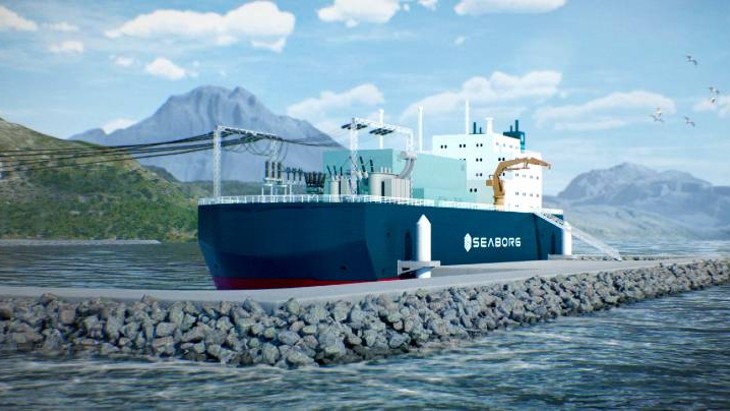Seaborg switches fuel plans because of HALEU timeline risks
05 July 2023
The Danish developer of floating Compact Molten Salt Reactors, Seaborg, has decided to change the fuel type for the initial power barges to low-enriched uranium (LEU) "due to the risks associated with developing a sufficient supply of high-assay low-enriched uranium (HALEU)" to meet its planned timeline.
 How one of its floating power barges could look (Image: Seaborg)
How one of its floating power barges could look (Image: Seaborg)
The switch from HALEU to LEU also means the moderator for the compact molten salt reactors (CMSR) will be changed from sodium hydroxide to graphite, Seaborg announced.
The company said the official switch followed talks with "key players" in the global fuel market about enabling "the necessary commercialisation of the supply chain for LEU-based fluoride fuel salt".
In June it signed a memorandum of understanding with Kepco Nuclear Fuel and GS Engineering & Construction to collaborate on investigating the feasibility of developing an LEU fuel salt production facility in South Korea.
Meanwhile, Urenco and Seaborg are to collaborate to "develop HALEU capacity for future CMSR product lines, while also investigating LEU fuel salt possibilities for the first product line".
Seaborg CEO Navid Samandari said: "We are happy to be working with such partners to develop the next generation of nuclear fuels which will help bring about Seaborg’s vision of decarbonising the world."
Seaborg's design is for modular CMSR power barges equipped with between two and eight 100 MWe CMSRs, with an operational life of 24 years. Instead of having solid fuel rods that need constant cooling, the CMSR's fuel is mixed in a liquid salt that acts as a coolant, which means that it will simply shut down and solidify in case of emergency. However, the low-enriched fluoride fuel salt is not yet commercially available.
In April 2022, Samsung Heavy Industries (SHI) and Seaborg signed a memorandum of understanding to manufacture and sell turnkey power plants combining SHI's ship-building expertise and Seaborg's CMSR. It also covered the development of hydrogen production plants and ammonia plants. SHI announced in January that it had completed the conceptual design for the CMSR Power Barge and obtained the basic certification of the design from the American Bureau of Shipping. In April, Seaborg established a consortium with Korea Hydro & Nuclear Power and SHI to develop floating nuclear power plants featuring Seaborg's CMSR technology. The consortium's first project is expected to be a 200 MWe Power Barge.
The timeline for Seaborg, which was founded in 2014, is for commercial prototypes of its CMSR to be built in 2026 with commercial production of Power Barges beginning from 2028.
Researched and written by World Nuclear News